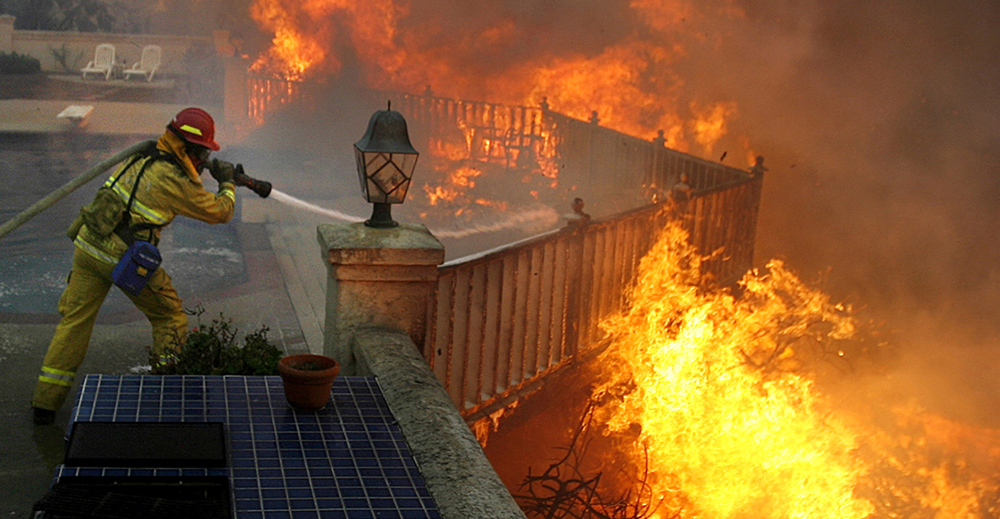Fires pose growing worldwide threat to wildland-urban interface
Scientists construct global maps of burned areas at edge of cities
Apr 16, 2024 - by David Hosansky
Apr 16, 2024 - by David Hosansky

A firefighter battles flames during the September 2012 Shockey wildland fire near San Diego. (Photo courtesy of Dept. of Homeland Security Science & Technology Directorate.)
Fires that blaze through the wildland-urban interface (WUI) are becoming more common around the globe, a trend that is likely to continue for at least the next two decades, new research finds.
The research team, led by scientists at the U.S. National Science Foundation National Center for Atmospheric Research (NSF NCAR), used satellite observations and machine learning techniques to produce a unique database of WUI areas and fires worldwide, dating back about two decades.
The overall number of all fires worldwide has declined, as has the total area burned.
However, the scientists found that the fraction of global fires that occur in WUI areas increased by about 23% from 2005 to 2020. Even more significantly, the global area burned by WUI fires during the same time increased by about 35% as a fraction of all burned areas.
The research found that WUI areas are expanding worldwide, especially in rapidly urbanizing regions in Africa. As newly constructed developments move into areas of wild vegetation, the risk of fires increases. The paper did not focus on the role of climate change, although the authors said the database can help scientists better fingerprint the role of climate change in fires.
WUI areas are generally defined as the location where urban land use and wildland vegetation come into contact or intermingle. Fires in such areas are especially dangerous, both because they imperil large numbers of people and structures and because, by burning manufactured materials instead of vegetation, they emit far more toxins than forest and grassland fires.
“Wildland-urban interface fires are a major concern for many people in the United States and globally, and through this study we now know they have increased in recent years and will likely continue doing so in the future,” said NSF NCAR scientist Wenfu Tang, the lead author of the new paper. “This is important as a first step to looking at emissions from these fires and their impacts on human health.”
Funding for the research came from NOAA. The study was published in Environmental Research Letters.
WUI fires have caused catastrophic destruction in recent years, sometimes burning down thousands of buildings and killing 100 or more people. Especially destructive fires include the 2009 Black Saturday bushfires in Australia, which left 173 dead, and the 2017 Pedrosa Grande Fire in Portugal, which killed 66 people. Last year’s Lahaina Fire in Hawaii was the deadliest in the United States in more than a century, killing 100 people and destroying more than 2,200 structures.
To understand more about trends in WUI fires, Tang and her colleagues turned to a global high-resolution map of WUI fires in 2020, which had been created by Franz Schug of the University of Wisconsin-Madison. They also analyzed data about Earth’s surface from NASA’s Moderate Resolution Imaging Spectroradiometer (MODIS) satellite instrument.
By applying machine learning techniques to the map and satellite data, they quantified the relationship of fires with such variables as land cover and population density. They then used those quantitative relationships to generate a global database of WUI areas and WUI fires, going back 20 years at a resolution of 9 kilometers (5.6 miles).
The researchers successfully confirmed the accuracy of the database by comparing it with independent WUI datasets previously developed for a few years within the same time period, including for the continental United States and globally.
In analyzing the new database, the researchers found that WUI areas have grown in all populated continents by 24% from 2001 to 2020, with the largest increase occurring in Africa.
Largely as a result, fires in WUI areas have also become more common. Since 2005, they have increased from 3.5% to 4.3% of all fires. In North America, the WUI fraction of all fire counts is even higher (up to 9%), with WUI fires in 2015-2020 becoming particularly large and more destructive.
“This is the first map of its kind that enables us to look at how WUI fires have been evolving globally over the past two decades,” said NSF NCAR scientist Cenlin He, a co-author of the study. “It shows that WUI fires have increased on every populated continent.”
Even as WUI blazes loom as a greater threat, the scientists noted that fires overall have been on the decline. Since 2005, the total number of fires worldwide decreased by 10%, and the amount of burned areas decreased by 22%, according to satellite observations analyzed in their research.
Tang and her colleagues then turned to the future. They integrated the WUI database with the NSF NCAR-based Community Earth System Model, which simulates global climate and fires, to determine the likely trends in WUI fires through 2030 and 2040.
If WUI areas continue to expand and greenhouse gases continue to be emitted at a high rate, they found that the WUI fraction of burned areas worldwide will likely increase by about 2.6-3.2% by 2040. However, the picture can change somewhat depending on changes in WUI areas and greenhouse gas emissions under different future scenarios, according to their analysis.
“This study is an important step in quantifying WUI fires and how they are changing worldwide,” Tang said. “As WUI areas rapidly expand and WUI fires become more frequent, it is critical to understand the interactions between WUI fires and human activities as well as the impacts of the fires on air quality, human health, and the environment.”